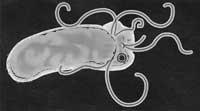Respiratory diagnosis
2000/09/01 Elhuyar Zientzia Iturria: Elhuyar aldizkaria
Helycobacter pylori produces chronic gastritis, peptic ulcers and possibly cancer in the human stomach. To detect the bacteria it is necessary to do endoscopy or biopsy to patients and then raise the bacteria. The diagnostic method, therefore, is slow and hard, in addition, can cause infection problems.
The other diagnostic route is to take advantage of the ability of the bacterium Helycobacter pylori to degrade urea: the patient ingests a carbon-13 urea and measures the amount of carbon-13 that contains carbon dioxide when exhaling. Carbon 13 atom is stable and non-harmful. But in order to carry out the diagnosis in this way, the cost of the apparatus and the technician were necessary until now.
However, a European Commission research team has developed a detector called IRIS Mark II. The use of the detector is simple (can be calibrated by the nurse herself), in addition to convenient and fast, it is 20-25 times cheaper than the growth of the bacteria. The IRIS device is very sensitive and can check H with 98% reliability. Whether or not Pylori bacteria have infected us. In addition, it has other applications such as liver and sand. However, despite the great technical advantages, the device has not yet extended too much.

Gai honi buruzko eduki gehiago
Elhuyarrek garatutako teknologia





